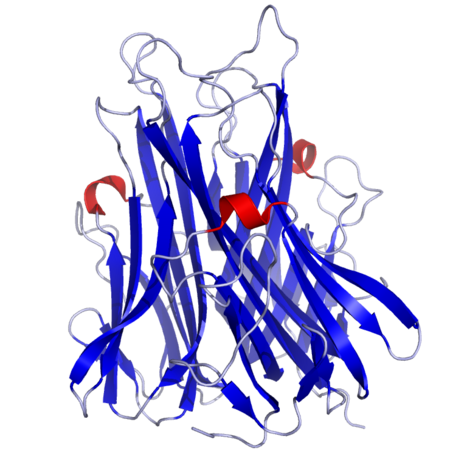Yếu tố hoại tử khối u alpha


Yếu tố hoại tử khối u alpha
1A8M, 1TNF, 2AZ5, 2E7A, 2TUN, 2ZJC, 2ZPX, 3ALQ, 3IT8, 3L9J, 3WD5, 4G3Y, 4TSV, 4TWT, 5TSW7124n/aENSG00000232810
ENSG00000228849
ENSG00000206439n/aP01375n/aNM_000594n/aNP_000585n/aYếu tố hoại tử khối u là các chất thuộc nhóm xitôkin được tiết ra bởi đại thực bào trong cơ thể, có khả năng tiêu huỷ nhiều tế bào của một số loại khối u. Tên này dịch từ nguyên gốc tiếng Anh: "Tumor Necrosis Factors" (viết tắt là TNF) dùng để chỉ một loại prôtêin đóng vai trò tín hiệu tế bào liên quan đến viêm toàn thân và tạo nên phản ứng giai đoạn cấp tính. Hai chất đầu tiên của họ TNF đã được xác định là: TNF anpha (yếu tố hoại tử khối u alpha viết tắt TNFa, cũng gọi là cachexin hoặc cachectin) và TNF bêta (còn được gọi là Lymphotoxin-alpha) một loại xitôkin bị ức chế bởi interleukin10.[3] Các TNF liên quan đến ung thư và đã được sử dụng để điều trị có hiệu quả một số bệnh ung thư.[4][5]TNF được sản xuất chủ yếu bởi các đại thực bào được kích hoạt, mặc dù nó có thể được sản xuất bởi nhiều loại tế bào khác như tế bào lympho CD4 +, tế bào NK, bạch cầu trung tính, tế bào mast, bạch cầu ái toan và tế bào thần kinh.[6] TNFα là một thành viên của siêu họ TNF, bao gồm các protein xuyên màng khác nhau với miền TNF tương đồng.Vai trò chính của TNF là trong việc điều hòa các tế bào miễn dịch. TNF, là một pyrogen nội sinh, có thể gây sốt, chết tế bào apoptotic, suy nhược, viêm và ức chế sự hình thành khối u và sao chép virus và đáp ứng với nhiễm trùng huyết thông qua các tế bào sản xuất IL1 & IL6. Rối loạn sản xuất TNF có liên quan đến nhiều loại bệnh ở người bao gồm bệnh Alzheimer,[7] ung thư,[8] trầm cảm lớn,[9] bệnh vẩy nến [10] và bệnh viêm ruột (IBD).[11] Mặc dù còn nhiều tranh cãi, các nghiên cứu về trầm cảm và IBD hiện đang được liên kết với mức độ tăng của TNFα.[12][13] TNF tái tổ hợp được sử dụng như một chất kích thích miễn dịch dưới INN tasonermin. TNF có thể được sản xuất ngoài tử cung trong bối cảnh ác tính và tương tự hormone tuyến cận giáp cả trong việc gây tăng calci máu thứ phát và trong các bệnh ung thư có sản xuất quá mức có liên quan.
ENSG00000228849
ENSG00000206439n/aP01375n/aNM_000594n/aNP_000585n/aYếu tố hoại tử khối u là các chất thuộc nhóm xitôkin được tiết ra bởi đại thực bào trong cơ thể, có khả năng tiêu huỷ nhiều tế bào của một số loại khối u. Tên này dịch từ nguyên gốc tiếng Anh: "Tumor Necrosis Factors" (viết tắt là TNF) dùng để chỉ một loại prôtêin đóng vai trò tín hiệu tế bào liên quan đến viêm toàn thân và tạo nên phản ứng giai đoạn cấp tính. Hai chất đầu tiên của họ TNF đã được xác định là: TNF anpha (yếu tố hoại tử khối u alpha viết tắt TNFa, cũng gọi là cachexin hoặc cachectin) và TNF bêta (còn được gọi là Lymphotoxin-alpha) một loại xitôkin bị ức chế bởi interleukin10.[3] Các TNF liên quan đến ung thư và đã được sử dụng để điều trị có hiệu quả một số bệnh ung thư.[4][5]TNF được sản xuất chủ yếu bởi các đại thực bào được kích hoạt, mặc dù nó có thể được sản xuất bởi nhiều loại tế bào khác như tế bào lympho CD4 +, tế bào NK, bạch cầu trung tính, tế bào mast, bạch cầu ái toan và tế bào thần kinh.[6] TNFα là một thành viên của siêu họ TNF, bao gồm các protein xuyên màng khác nhau với miền TNF tương đồng.Vai trò chính của TNF là trong việc điều hòa các tế bào miễn dịch. TNF, là một pyrogen nội sinh, có thể gây sốt, chết tế bào apoptotic, suy nhược, viêm và ức chế sự hình thành khối u và sao chép virus và đáp ứng với nhiễm trùng huyết thông qua các tế bào sản xuất IL1 & IL6. Rối loạn sản xuất TNF có liên quan đến nhiều loại bệnh ở người bao gồm bệnh Alzheimer,[7] ung thư,[8] trầm cảm lớn,[9] bệnh vẩy nến [10] và bệnh viêm ruột (IBD).[11] Mặc dù còn nhiều tranh cãi, các nghiên cứu về trầm cảm và IBD hiện đang được liên kết với mức độ tăng của TNFα.[12][13] TNF tái tổ hợp được sử dụng như một chất kích thích miễn dịch dưới INN tasonermin. TNF có thể được sản xuất ngoài tử cung trong bối cảnh ác tính và tương tự hormone tuyến cận giáp cả trong việc gây tăng calci máu thứ phát và trong các bệnh ung thư có sản xuất quá mức có liên quan.
Thực đơn
Yếu tố hoại tử khối u alphaLiên quan
Tài liệu tham khảo
WikiPedia: Yếu tố hoại tử khối u alpha